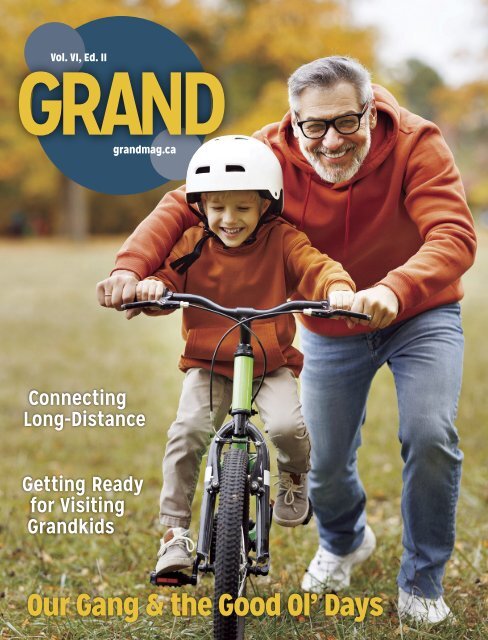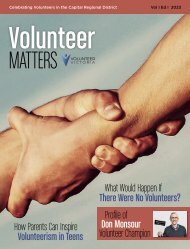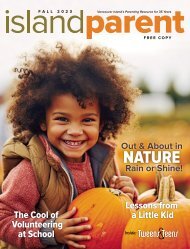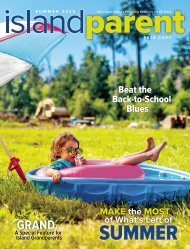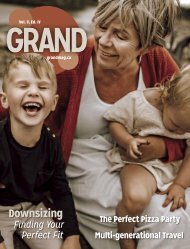GRAND Vol VI, Ed II
GRAND honours and supports grandparents by providing information on resources and businesses for families and a forum for the exchange of ideas and opinions: Connecting Long-Distance • Our Gang & the Good Ol’ Days • Getting Ready for Visiting Grandkids
GRAND honours and supports grandparents by providing information on resources and businesses for families and a forum for the exchange of ideas and opinions: Connecting Long-Distance • Our Gang & the Good Ol’ Days • Getting Ready for Visiting Grandkids
Create successful ePaper yourself
Turn your PDF publications into a flip-book with our unique Google optimized e-Paper software.
<strong>Vol</strong>. <strong>VI</strong>, <strong>Ed</strong>. <strong>II</strong><br />
<strong>GRAND</strong><br />
grandmag.ca<br />
Connecting<br />
Long-Distance<br />
Getting Ready<br />
for Visiting<br />
Grandkids<br />
Our Gang & the Good Ol’ Days<br />
grandmag.ca<br />
<strong>Vol</strong>. <strong>VI</strong>, <strong>Ed</strong>. <strong>II</strong> 1
Technology<br />
Connecting Long-Distance<br />
Grandparents and grandchildren often share a very important<br />
emotional bond and both groups can benefit<br />
from a strong relationship. When grandparents and<br />
grandchildren live far apart, it can be difficult for them to<br />
stay connected. Fortunately, technology can help fill the gap<br />
and bridge the distance divide. One way to do this is through<br />
video calling systems like FaceTime, Zoom or other video<br />
conferencing platforms. We have studied this topic extensively<br />
in my research group at Simon Fraser University with<br />
an emphasis on young grandchildren between the ages of 4<br />
and 10. Here are some things that we have learned.<br />
First, video chat is typically loved by both grandparents<br />
and young grandchildren because each gets to see the other.<br />
This should come as no surprise. Yet even with video going,<br />
it can be challenging to keep a child’s attention over a<br />
video call. Unlike a conversation between two adults, young<br />
grandchildren are unlikely to be able to maintain a conversation<br />
beyond 10 to 15 minutes until they get to the pre-teen<br />
years. Research has shown this is better than phone calls,<br />
however, where typically the attention span of children is<br />
far less than video calls.<br />
Because of a child’s short attention, it is important for<br />
grandparents to be able to focus video calls around a child’s<br />
interests. The grandparents who were able to do this in our<br />
studies tended to have longer and more enjoyable conversations.<br />
For example, some grandparents figured out the<br />
names of a child’s friends and could then directly ask about<br />
them. Some learned about their grandchildren’s extra-curricular<br />
activities ahead of time so that they could ask how<br />
things were going. Young grandchildren also enjoy showing<br />
off their toys or things that they create at school. Some<br />
grandparents would ask parents ahead of time about these<br />
objects so they would know which to ask their grandchildren<br />
about when talking with them. Young children are also interested<br />
in learning about things from their grandparents<br />
that are different from their own location. This might be<br />
related to different time zones, the weather, or culture and<br />
heritage.<br />
Some grandparents were in our studies even more creative—for<br />
example, one grandmother learned that her<br />
grandson was interested in armies and camouflage and so<br />
she made him a camouflage blanket and mailed it to him.<br />
When they talked over a video call, they would spend large<br />
amounts of time talking about the blanket and making up<br />
stories about it together.<br />
Having read the above, you might be thinking, this sounds<br />
pretty easy. Well, truth be told, it isn’t, as many grandparents<br />
can likely attest to. There are many social challenges<br />
that make grandparent and grandchild communication over<br />
distance still difficult.<br />
Video calls between young grandparents and grandchildren<br />
can require a lot of parent scaffolding—that is, help<br />
from parents to keep the call going. Parents often have to be<br />
the ones that perform the “camera work” where they hold<br />
a tablet or cell phone and move it to make sure the children<br />
are in view. Some children can do this on their own, but it<br />
can easily be disorienting for grandparents who are watching.<br />
The camera might end up facing the floor, the ceiling<br />
or be an overly close up view of a child’s face. What we have<br />
seen to be immensely valuable are tablet or mobile phone<br />
stands that can be easily set on a table or even the floor,<br />
where the device can be easily angled towards a child’s general<br />
area and left stationary. This reduces the need for parents<br />
to continually perform camera work.<br />
Some grandparents feel apprehensive or self-conscious<br />
about video calling their grandchildren. This is because they<br />
may not know a lot about their grandchildren and are afraid<br />
of saying the “wrong” thing or annoying their grandchildren.<br />
They may not know who their friends are at school in<br />
order to ask about them; they may not about their favourite<br />
activities; or, they may not feel that a child wants to learn<br />
about the grandparents’ cultural heritage. These are all very<br />
2 <strong>GRAND</strong> grandmag.ca
eal issues and sometimes it’s the case that grandparents can<br />
have a tough time learning about their grandchildren in a<br />
deep enough way to sustain conversations or feel like they<br />
are able to really connect over video calls.<br />
Many grandparents talk with a child’s parents to learn<br />
about these things so they know what they could talk about.<br />
Some parents might be too busy though, or the relationship<br />
between a grandparent and their adult child may not be<br />
strong and so asking questions that might help them connect<br />
with their grandchildren is less possible. There is no<br />
easy solution to such problems. Start small. For example, a<br />
grandparent could ask a young child to show them their favourite<br />
toy, explain why they like it so much and show them<br />
what it might do. Or, a grandparent could think about what<br />
is unique to their own location when compared to a child’s.<br />
Is the weather noticeably different outside? Could the grandparent<br />
show a very hot day, a lot of rain or some snow over<br />
the video call? Does the grandparent have different pets that<br />
the grandchild may not have, or vice versa? Could they easily<br />
be shown over FaceTime? These types of acts could be a<br />
starting to point to longer term engagements with a child,<br />
leading to longer conversations and more things to talk<br />
about and show.<br />
Video calling through technologies like FaceTime or Zoom<br />
can be a valuable way for grandparents and young grandchildren<br />
to connect over distance. It isn’t always easy and<br />
grandparents can try to focus conversations around key<br />
topics of interest to children. There should also be thought<br />
over how to reduce the need for lots of camera work—tablet<br />
or mobile phone stands can work very well and placing the<br />
camera in a stationary location is a great first step.<br />
Dr. Carman Neustaedter is a Professor and<br />
Dean of the Faculty of Communication, Art and<br />
Technology at Simon Fraser University. He is<br />
an international expert in telepresence and<br />
technology design for families.<br />
grandmag.ca<br />
<strong>Vol</strong>. <strong>VI</strong>, <strong>Ed</strong>. <strong>II</strong> 3
Grandparenting<br />
Our Gang & the Good Ol’ Days<br />
When I think back to my childhood<br />
in the 1960s, I can’t help but reminisce<br />
about our neighborhood<br />
gang. This gaggle of children was fluid—<br />
it included anyone from our surrounding<br />
blocks who could come out to play on any<br />
given day. Sometimes it swelled in numbers<br />
on weekends and school holidays<br />
and other times it involved only a core<br />
group of us. And despite all the different<br />
personalities and ages it encompassed, it<br />
generally worked.<br />
Back then we were largely responsible<br />
for our own entertainment. When the<br />
weather was warm, we banded together<br />
to ride bikes, sail fleets of paper boats<br />
and play games—Red Rover was a classic!<br />
Even during the long, cold winters,<br />
we still spent a lot of time outdoors, sledding,<br />
skating or building snow forts and<br />
snowmen.<br />
Neighborhoods back in the 60s were<br />
different from those today. Families tended<br />
to stay put so kids grew up with the<br />
same group of friends, forming strong<br />
bonds as a result. It was like being part<br />
of a big extended family. Kids ran freely<br />
without much parental supervision even<br />
at a young age as they were always accompanied<br />
by older siblings.<br />
In my hometown, we had a four- or<br />
five-block radius where we roamed and<br />
played. We also had the added benefit of<br />
living directly across from a park that<br />
spanned an entire city block, so that<br />
alone provided ample space to play.<br />
Most mothers back then were stay-athome<br />
moms as it was entirely possible<br />
for a family to live comfortably on only<br />
one income. So children came home after<br />
school, they didn’t have to attend afterschool<br />
care. And structured activities/<br />
lessons were rare; we simply created our<br />
own fun. The odd one of us may have<br />
taken music lessons or perhaps a few<br />
swimming lessons, but the majority of us<br />
learned things the hard way—through a<br />
combination of trial and error and stubborn<br />
determination, with an older sibling<br />
most likely egging you on.<br />
Being part of this gang gave all of<br />
us free reign in each other’s yards and<br />
homes: we wandered in and out of whoever’s<br />
house was closest to go to the bathroom,<br />
we knew which mom baked the<br />
best cookies, and we knew which parent<br />
(or grandparent) would give us change to<br />
buy penny candy at the corner store.<br />
And what would a neighborhood gang<br />
be without the classic neighborhood<br />
bully? We certainly had ours. He was<br />
the older sibling of some our playmates<br />
and he was known far and wide in the<br />
neighborhood as trouble with a capital<br />
“T.” He actually seemed to relish his<br />
reputation, wearing it almost like a badge<br />
of honour. He teased relentlessly, interrupted<br />
or ruined our games and wreaked<br />
havoc on anything we constructed. And<br />
I’m afraid that in our collective fear, we<br />
made no attempt to include him in our<br />
play; in fact, we dutifully avoided him<br />
like the plague. With hindsight, I am sure<br />
we only exacerbated the problem. I have<br />
to wonder if his interactions, however<br />
4 <strong>GRAND</strong> grandmag.ca
negative, were merely his misguided attempts<br />
at inclusion.<br />
I distinctly remember one summer<br />
when the rumor mill identified this bully<br />
as the likely culprit who had pilfered an<br />
apple from our back yard apple tree. And<br />
this was no ordinary apple. It was one<br />
that had grown to gigantic proportions,<br />
and it was quite simply my father’s pride<br />
and joy. He forbade any of us to pick it.<br />
If there was a Guinness Book record<br />
for the largest apple, this one certainly<br />
would have rivalled it. It was the talk<br />
of the neighborhood. We would stand<br />
underneath that apple tree, and “oohhh”<br />
and “ahhh” just gazing upwards through<br />
the foliage. Until one day, later in the<br />
fall, that marvelous apply simply disappeared.<br />
A quick investigation proved it<br />
hadn’t grown too heavy as it wasn’t found<br />
at the base of the tree. Well, you can<br />
imagine my father’s ire. Alas, there was<br />
no proof, so the apple bandit was never<br />
caught, much to my father’s dismay, but<br />
he certainly blamed you know who.<br />
Bullies aside, it saddens me that many<br />
children today do not have the opportunity<br />
to experience being part of a neighborhood<br />
gang. Neighborhoods seem to be<br />
different nowadays, I imagine because of<br />
the mobility of families and the simple<br />
fact that many households have two<br />
working parents.<br />
Our neighborhood gang served a purpose—Friendship.<br />
Safety. Belonging.<br />
Loyalty. Within its familiar confines, we<br />
learned the give and take of relationships,<br />
how to negotiate with others, the<br />
art of compromise and the importance<br />
of sharing and being kind with one another.<br />
It was like a mini-microcosm that<br />
prepared us for the wider world. Looking<br />
back, it easily brings to mind some of my<br />
fondest childhood memories.<br />
Susan Gnucci is a local<br />
author and a proud “nonna”<br />
to two young grandsons.<br />
She enjoys sharing her<br />
experiences as a<br />
grandparent.<br />
Check out the upcoming<br />
Family Resource Guide<br />
Celebrating the modern family lifestyle on the West Coast<br />
WESTCOASTFAMILIES.COM<br />
FREE!<br />
2022<br />
Your Family<br />
Resource<br />
Guide<br />
<strong>Ed</strong>ucation<br />
Classes & Programs<br />
Family Fun & Entertainment<br />
The annual Family Resource Guide offers a comprehensive guide to businesses,<br />
organizations and services of interest to families. It includes opportunities to<br />
advertise your products and services to families from Abbotsford to<br />
North Vancouver. You will certainly want to be part of this publication<br />
that reaches families year round.<br />
Distribution continues for a full year. Distribution outlets include grocery stores,<br />
recreation centres, libraries and more. It is estimated that over 40,000 families pick<br />
up the Family Resource Guide at over 250 locations across the lower mainland!<br />
Email Info@westcoastfamilies.com for more information<br />
grandmag.ca<br />
<strong>Vol</strong>. <strong>VI</strong>, <strong>Ed</strong>. <strong>II</strong> 5
Grandparenting<br />
Getting Ready for Visiting Grandkids<br />
There’s nothing like having your<br />
grandkids come over for a visit—especially<br />
when you have everything<br />
you need on hand. This list is best suited<br />
to grandchildren ages 2–5, but may be<br />
adapted to suit other ages.<br />
1. A Car Seat<br />
It is now recommended to have children<br />
in a car seat or booster seat until<br />
they are about nine years old, depending<br />
on their weight and height. Babies<br />
should stay rear-facing until one year,<br />
but it is safest for toddler and preschoolers<br />
to remain in a rear-facing car seat<br />
for as long as possible. (bcaa.com/community/child-car-seat-safety).<br />
Make<br />
sure you have an appropriate car seat<br />
and know how to install and use it.<br />
2. A Yes-Zone<br />
Grandparents’ houses are good places<br />
for children to learn how others live,<br />
and how to behave in a home that is not<br />
their own. It is a good idea to set boundaries<br />
about what kids can touch, where<br />
to put their shoes and which rooms they<br />
can go into. But don’t forget to designate<br />
a yes-zone: part of your home where<br />
nothing is off-limits. When the adults<br />
can relax, the kids have more fun and<br />
you can all work on developing a real<br />
and meaningful relationship!<br />
3. Outdoor Time<br />
One of the best ways to deal with kids<br />
who are getting a little grumpy is to take<br />
them outdoors. But do a little reconnoitering<br />
beforehand. Find the best parks,<br />
beaches and playgrounds near you. If<br />
Eva Bild is a childbirth, parenting<br />
and lactation educator and doula<br />
trainer. She has been working<br />
with new families since<br />
1992. Eva is founder of the<br />
Mothering Touch Centre. She is the mother of<br />
three wonderful adults, but most excitingly,<br />
she is now a grandmother! evabild.ca<br />
you are living in the home where you<br />
brought up your kids, you may know<br />
some of those destinations. But some<br />
may have changed in the last 30 years!<br />
And if you are living in a new place, you<br />
will need to start from scratch. Chat<br />
with some new parents in your neighbourhood<br />
to get their recommendations.<br />
4. Bath Time<br />
The other best way to cheer up a<br />
grumpy child is to put them in water. If<br />
you can’t get to a pool, a bath with new<br />
bath toys, or just some plastic containers<br />
and scoops can be really fun! Add colour<br />
with a couple drops of food colouring.<br />
Or check out bath crayons.<br />
5. Snacks<br />
Check with your grandchildren’s parents<br />
about what foods they might not<br />
be allowed or are allergic to. And then,<br />
within those boundaries, stock up on<br />
snacks. Plan for some pre-meal fresh<br />
fruit and veggies then when dinner is<br />
served, the kids will have already eaten<br />
their vegetables!<br />
6. Cooking and Baking<br />
Plan a simple baking project. Buy<br />
a little apron, perhaps a small rolling<br />
pin, some fun cookie cutters. Be aware<br />
that for preschoolers, cooking is a rich<br />
sensory process. They need to feel, grab,<br />
taste, smell and smear everything! It’s<br />
not going to be tidy, so relax and explore<br />
with your grandchild. Smell the cinnamon,<br />
taste the sugar and the salt and<br />
the baking powder (yuck!). Focus on the<br />
process, and don’t worry too much about<br />
the product. Enjoy!<br />
7. Toys<br />
You may be tempted to get a whole<br />
bunch of toys to amuse your grandchildren<br />
while they are visiting. Be careful!<br />
A few toys go a long way. And they<br />
make less mess. Building toys (blocks,<br />
Lego, Duplo) are very versatile and fun<br />
for all ages. Puzzles are great, but make<br />
sure they are age-appropriate and not<br />
too frustrating. Think about toys that<br />
encourage interaction and playing together.<br />
Having a big toy bin will make<br />
clean-up easy.<br />
8. Gardening<br />
If you like gardening, and have a garden,<br />
think about how you can share that<br />
pleasure with your grandkids. Can you<br />
give them a little spot they can dig in? A<br />
few seeds to “plant?” A little apron, some<br />
tiny gardening gloves, a small trowel<br />
and bucket. Make sure the tools are<br />
“real.” Plastic tools are often disappointing.<br />
My children’s grandmother taught<br />
them a lot about the names of flowers<br />
and plants, and weeds too. That’s a way<br />
of sharing a love of plants even if you<br />
don’t have a garden.<br />
9. Outings<br />
Grandparents are important in teaching<br />
children about their culture and<br />
heritage. Taking your grandchildren<br />
to museums, community festivals and<br />
events, concerts and movies is a great<br />
way to do that. Don’t expect too much of<br />
the kids’ attention span though. Be prepared<br />
with a lot of snacks and a really<br />
good attitude yourself! And be prepared<br />
to bail and go home if it just doesn’t<br />
seem like the right day for this outing.<br />
Try again next year!<br />
10. Downtime<br />
When your grandchildren come to<br />
visit, things can get intense. There may<br />
be too many people, too many family<br />
events, too many outings. Make sure<br />
there is a quiet time every day, when<br />
you and your grandchild can cuddle and<br />
read books or watch a movie. With any<br />
luck, that will turn into a nap! What a<br />
delight!<br />
If there have been several high-energy,<br />
event-filled days in a row, declare a<br />
hang-out day. Stay home. Wear pyjamas.<br />
Eat cereal. Make playdough. (thebestideasforkids.com/playdough-recipe)<br />
Build a blanket fort. Those memories are<br />
golden!<br />
6 <strong>GRAND</strong> grandmag.ca
SUMMER<br />
CAMPS<br />
and more!<br />
Qwanoes.ca<br />
1-888-997-9266<br />
grandmag.ca<br />
<strong>Vol</strong>. <strong>VI</strong>, <strong>Ed</strong>. <strong>II</strong> 7
Gone are the days of rocking chairs and<br />
recliners. Today’s grandparents are more<br />
likely to be rock climbing or going for a run<br />
than they are to be rocking or reclining.<br />
<strong>Vol</strong>. <strong>VI</strong>, <strong>Ed</strong>. <strong>II</strong><br />
RAND<br />
grandmag.ca<br />
Connecting<br />
Long-Distance<br />
Getting Ready<br />
for Visiting<br />
Grandkids<br />
Our Gang & the Good Ol’ Days<br />
Jim Schneider Publisher<br />
publisher@islandparent.ca<br />
Sue Fast <strong>Ed</strong>itor<br />
editor@islandparent.ca<br />
Kristine Wickheim Account Manager<br />
kristine@islandparent.ca<br />
RaeLeigh Buchanan Account Manager<br />
raeleigh@islandparent.ca<br />
<strong>GRAND</strong>, published by Island Parent Group Enterprises Ltd., is a digital<br />
publication that honours and supports grandparents by providing<br />
information on resources and businesses for families and a forum<br />
for the exchange of ideas and opinions. Views expressed are not<br />
necessarily those of the publisher. No material herein may be<br />
reproduced without the permission of the publisher.<br />
518 Caselton Place, Victoria, BC V8Z 7Y5<br />
250-388-6905 grandmag.ca<br />
A proud member of<br />
BC<br />
We’re an active and diverse group—an engaged,<br />
evolving and powerful force. We’re<br />
mentors, nurturers, keepers of secrets.<br />
We’re caregivers, child care providers,<br />
dessert-before-dinner defenders. We’re<br />
historians, spiritual guides and the holders<br />
of family stories.<br />
<strong>GRAND</strong> celebrates who you are as a grandparent<br />
and who you are as an individual.<br />
You love spending time with your grandchildren<br />
and you’re happy in your other<br />
roles: at work, in the community and on<br />
your own. <strong>GRAND</strong> acknowledges that you<br />
are not “one or the other”—an “either/or”<br />
version of yourself—you are many different<br />
things to many different people. And to<br />
yourself.<br />
With an Island perspective that speaks<br />
to an international readership, <strong>GRAND</strong> is<br />
the source for on-the-go grandparents of<br />
up-to-the-minute and thought-provoking<br />
information and ideas—on everything from<br />
having fun, staying fit and things to do to<br />
travel, leisure, health and technology. Think<br />
of <strong>GRAND</strong> as a trusted friend who happily<br />
shares those “senior moments” (in the<br />
best sense of the words!) and keeps you<br />
informed and connected to the issues and<br />
ideas that really matter. After reading an<br />
issue of <strong>GRAND</strong>, you should feel inspired,<br />
up-to-date and informed.<br />
We’re here for you: from helping you<br />
figure out where you fit in to tackling your<br />
most perplexing questions, sharing your<br />
greatest discoveries and celebrating your<br />
deepest joys.<br />
<strong>GRAND</strong> features articles on topics ranging<br />
from the importance of storytelling,<br />
cooking with your grandkids and community<br />
superheroes, to photographing your<br />
grandkids, gift-giving and grandparenting<br />
from afar. There are ideas and inspiration<br />
to help keep you in-the-know and connected,<br />
there’s a guide to investing in your<br />
grandchildren’s future and there’s tech<br />
support that will help you face your fears<br />
and embrace the cloud.<br />
<strong>GRAND</strong> is as diverse and engaged as you<br />
are. Together, we’re a powerful and positive<br />
force—in our grandchildren’s lives and<br />
in our communities.<br />
8 <strong>GRAND</strong> grandmag.ca
BURNABY ONLINE<br />
Learn where you want, when you want<br />
August Completion Courses<br />
COURSES OFFERED:<br />
Career Life <strong>Ed</strong>ucation 10<br />
Éducation au Choix de Carrière et de Vie 10<br />
Physical and Health <strong>Ed</strong>ucation 10<br />
Spanish 10, 11, 12 • French 11<br />
Intro Spanish 11 • Intro Italian 11<br />
Contemporary Indigenous Studies 12<br />
20th Century World History 12<br />
Physical Geography 12<br />
BC First Peoples 12<br />
Photography 12 • Art 11<br />
Visit our website, listed below, for registration information<br />
Ministry approved<br />
BC curriculum<br />
Kindergarten to<br />
Grade 12 program<br />
Contemporary Indigenous<br />
Studies and BC<br />
First Peoples 12 available<br />
for enrollment<br />
Full time or part time<br />
available Grade 10<br />
to 12<br />
Adult Learning<br />
options<br />
Grade 8 to 12: over<br />
50 course options<br />
Innovative Learning<br />
Management system<br />
Experienced Online<br />
learning teachers<br />
Opportunities for<br />
self-paced, flexible,<br />
convenient learning<br />
BURNABY SCHOOL DISTRICT ONLINE PROGRAM<br />
Open to all residents of British Columbia<br />
grandmag.ca<br />
online.burnabyschools.ca<br />
Registration: online.burnabyschools.ca/registration<br />
Direct teacher<br />
support available<br />
Develop communication<br />
and technical<br />
online skills registering<br />
full-time <strong>Vol</strong>. or for <strong>VI</strong>, <strong>Ed</strong>. a <strong>II</strong> single 9<br />
course


